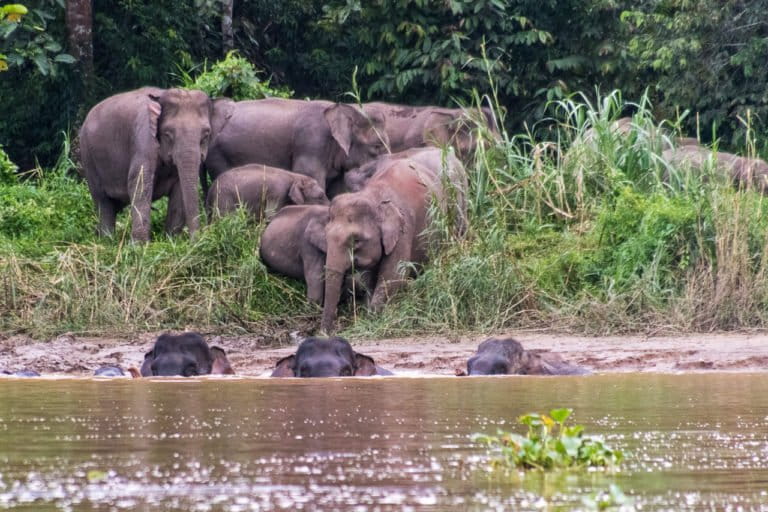- A newly published study shows that elephants in Malaysia prefer habitats found outside of protected areas, with most of the elephants observed having more than half their home range outside protected areas.
- The main reason for this is that their preferred foods are more abundant in the kind of disturbed landscapes that humans create, such as plantations or secondary
- The study’s findings have important implications for Asian elephant conservation, showing that the current network of protected areas alone isn’t enough and that human-wildlife conflict needs to be managed.
Over the span of 10 years, a team of researchers have been following 102 Asian elephants in Malaysia, collecting more than 600,000 GPS fixes in the process.
When they analyzed the data, the team found that the elephants preferred habitats on the edges of and surrounding protected areas rather than inside them, raising important questions for the conservation of elephants in the region.
“This is the most comprehensive analysis of Asian elephant movements and habitat relationships to date,” said Ahimsa Campos-Arceiz, a conservation ecologist at China’s Xishuangbanna Tropical Botanical Garden, and a co-author of the published findings. “Most elephants had more than half their home range outside of protected areas with only a few individuals having more than 75% of their home range inside protected areas.”
The wide-ranging study followed the Indian elephant subspecies (Elephas maximus indicus), in Peninsular Malaysia, and the Bornean subspecies (E. m. borneensis), in the state of Sabah, to understand their ranging behavior. It may seem counterintuitive that elephants would prefer to spend their time outside of protected areas, risking conflict with humans, but there’s one big motivation: food.
“Against what most people might assume, old-growth tropical rainforests do not provide much food for elephants,” says Benoît Goossens, a conservation biologist at Cardiff University and co-author of the study. “Old-growth rainforests are super-efficient systems where most of the plants are heavily protected with secondary compounds (toxins) to deter herbivores.”
The foods that elephants prefer, such as grasses, lianas, bananas and fast-growing trees, are far more prevalent in human-influenced landscapes, such as plantations or secondary-growth forest. With an adult elephant needing to find around 150 kilograms (330 pounds) of food per day, they naturally gravitate toward where more food is available.

Another contributing factor is the very location of protected areas, says John Payne, executive director of the conservation NGO Bringing Back Our Rare Animals (BORA) in Sabah, who was not involved in the study.
“All the large terrestrial protected areas in Malaysia exist only because they are on terrain that is very marginal or impossible for human use,” he says. “None were chosen to be able to support a viable population of elephants.”
That’s not to say that protected areas aren’t important for elephants. The study data show that while elephants prefer disturbed habitats, they don’t stray far from the forest. The research team hypothesizes that the elephants stay close to the protected forest areas for refuge, showing that these areas still have a vital role to play.
One of the most important implications of the study is that human-wildlife conflict is to some degree inevitable and therefore needs to be managed, Payne says.
“I would like to see less use of the fluffy term ‘conservation’ which, in my view, helps to undermine serious discussion and meaningful discussion,” he said. “Large animals, especially those that cause problems to humans, need to be managed.”
The research team have proposed several suggestions for dealing with human-wildlife conflict, including increasing food availability in disturbed areas within protected areas by planting grasses; land-use planning that considers elephant behavior; physical barriers in areas where conflict is frequent; financial compensation mechanisms; promotion of human-elephant coexistence; and, when all else fails, elephant translocation.

Despite the challenges, Campos-Arceiz and Goossens say there are a few reasons to remain positive. While data on Malaysia’s elephant numbers is patchy, the population currently seems to be stable and not dramatically declining. In addition, they say, human-elephant conflict in Malaysia predominantly involves damage to property, like loss of crops, rather than people being injured or killed. Malaysia has a highly urbanized population with low rural population density, so it should be possible to set aside land for conservation. Malaysia is also an upper-middle-income country that can afford to invest in conservation. And lastly, Malaysia has shown a commitment to conservation at a national level, including producing an Elephant Conservation Action Plan for Peninsular Malaysia and Bornean Elephant Action Plan for Sabah.
“Our results have important implications for Asian elephant conservation, they show that protected areas are very important but not enough as an overall strategy for Asian elephant conservation,” Campos-Arceiz says. “Our key recommendation is to try and understand and integrate Asian elephant behavioral ecology in our efforts to conserve them.”
Banner image: A herd of Bornean elephants, by A herd of Bornean elephants, by BurakovaLP via Wikimedia Commons (CC BY 4.0).
Citation:
de la Torre, J. A., Cheah, C., Lechner, A. M., Wong, E. P., Tuuga, A., Saaban, S., … Campos-Arceiz, A. (2022). Sundaic elephants prefer habitats on the periphery of protected areas. Journal of Applied Ecology. doi:10.1111/1365-2664.14286
Related reading:
Saving Sumatran elephants starts with counting them. Indonesia won’t say how many are left
Editor’s note: This article was amended to correct Ahimsa Campos-Arceiz’s primary institutional affiliation.
FEEDBACK: Use this form to send a message to the author of this post. If you want to post a public comment, you can do that at the bottom of the page.
